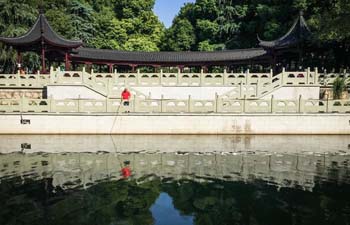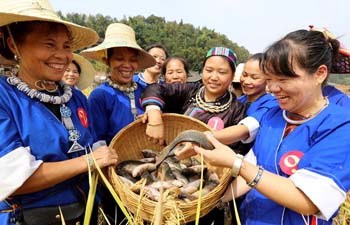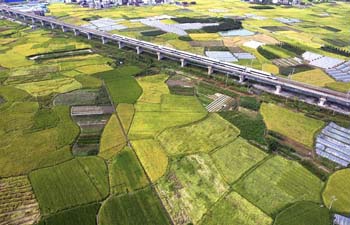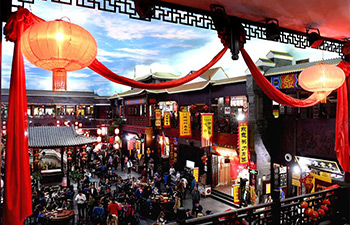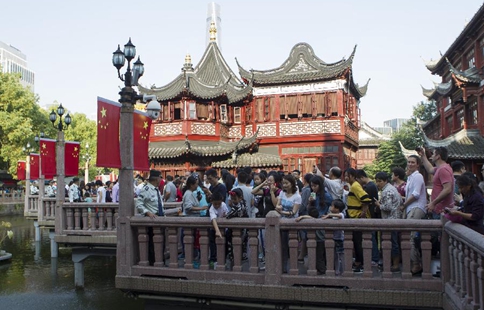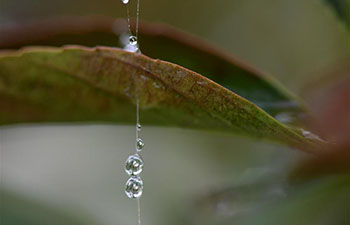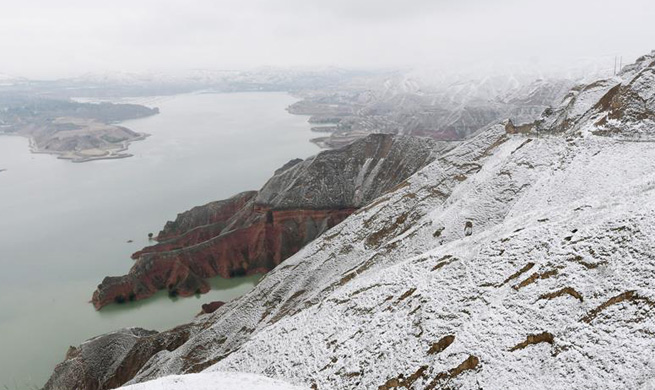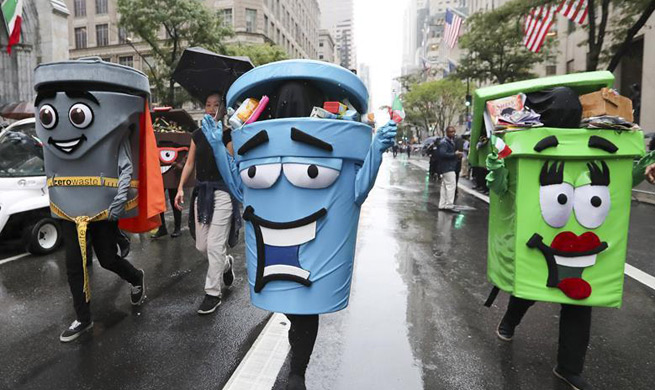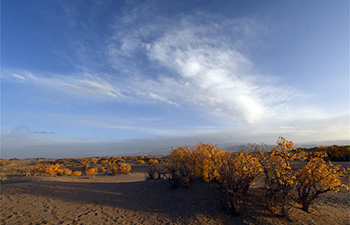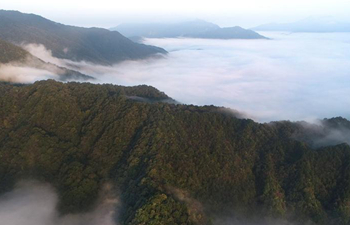By Xinhua writers Liu Wei, An Yang and Qu Ting
BEIJING, Oct. 10 (Xinhua) -- Beijing-born photographer Lyu Yang is fascinated by everything about the Forbidden City. Over the past decade, the 35-year-old has taken pictures of this century-old complex every week.
Lyu often volunteers to tell stories about the museum's history and cultural objects to foreign visitors. His five-year-old daughter also takes a great interest in the stories and is fond of the history-themed activites at the Palace Museum.
In recent years, the museum has been revitalized and gained fame online.
"China's economic growth has brought better lives for Chinese people, yet modern life has alienated many from traditional culture. What the museum has done is to creatively attract people to get closer to traditional treasures," said Lyu.
LIVENING UP THE ANCIENT PALACE
Curator Shan Jixiang is the man behind the scenes. Since 2012, the self-proclaimed "gatekeeper of the museum" launched a comprehensive field research project on the museum.
Over the course of five months, he stepped foot in every one of the 9,000-plus rooms, wearing out 20 pairs of cloth shoes. The former director of the State Administration of Cultural Heritage could even recall the exact number of cultural relics housed in the museum.
As the largest collection of preserved ancient wooden structures in the world, the museum houses more Chinese treasures and is among the most visited attractions in the world.
"But do these facts matter?" Shan said in a recent interview with Xinhua. "If 70 percent of its space is not open to the public and 99 percent of its relics are not showcased to patrons -- or if visitors don't look at any exhibitions but just walk down the central axis from the front entrance to the back gate -- it is not a museum that people can enjoy from the bottom of their hearts."
He said changes must be made if the Palace Museum cannot reach out to the public and affect their real lives.
In five years, the museum has increased the proportion of the area of the Forbidden City open to the public to 76 percent. The 2,800-square-meter Yan Chi building of Wu Gate used to be a storehouse, but now has been renovated to be an exhibition hall to showcase precious historical relics from other countries.
This year, the first exhibition of Afghan cultural relics in China, exhibitions featuring French jewelry from the 18th century, and cultural relics from the Maritime Silk Road have all been displayed.
"We have built 20 viewing platforms that enable visitors to ascend to the top to take a close look at the structure of ancient buildings and the delicate paintings on them. We have even opened the walls to the public so tourists can look out over the Forbidden City and watch a 25-minute VR film to learn how the Palace Museum was built from thousands of pieces of wood and without even one single nail," said Shan.
In 2016, "Masters in the Forbidden City," a documentary series that profiled the work of museum conservators became a surprise online hit.
"It takes a seasoned conservator a whole year to restore just three to four paintings. This spirit of craftsmanship is in our blood," said Lyu, who has watched the documentary three times.
CHINA SHARES ITS EXPERIENCE
Shan, 63, is proud of what the museum has done. After visiting many countries with ancient civilizations, he came to realize that all cultural traditions, no matter in China or elsewhere, are passed down through generations and worthy of respect.X "Every single person in the world is responsible for protecting and preserving cultural relics and passing on cultural diversity. However, many glorious civilizations have faced various threats," said Shan.
In 2015, Shan went to Afghanistan. He was asked to put on a bullet-proof jacket once he boarded the airplane. When he arrived, he wasn't able to visit local historical relics because of social unrest.
That's when he got the idea to build a dialogue platform for countries with ancient civilizations to work to preserve them despite natural disasters, war, terrorism, illegal sales and improper protection methods.
With the support of the Chinese government, the first and second Taihe Forum were held in Beijing for two consecutive years starting in 2016. The theme of this year's forum was "Echoes of the Ancient Civilizations" and delegates from 21 countries and three international organizations attended the forum in September and shared views on addressing challenges and exploring effective conservation practices.
"ISIS has bombarded cultural relics in Iraq -- even Al-Hadba' Minaret and Al-Nouri Mosque. Local culture and cultural diversity in Iraq are in great jeopardy," said Fryad Rwandzi, Iraqi Minister of Culture, Tourism and Antiquities.
Shan said at the forum that the museum has sponsored a Taihe Forum Fund to provide academic and technical support for countries facing troubles, such as Iraq and Syria due to war and terrorist attacks and Mexico following earthquakes.
Olga Orive, an archeologist and member of the Executive Committee of the International Council on Monuments and Sites (ICOMOS, Mexico), expressed her gratitude and was impressed by the restoration skills of the museum.
"Similarly, we have a 'relics hospital' in Mexico, but our techniques, equipment and specialized conservators are in short supply. Mexico and China should collaborate more in such fields," said Orive.
PRESERVATION URGENTLY NEEDED
"The Palace Museum has built a communication mechanism for all countries. Three decades ago, you could hardly imagine conservation experts talking about how to combat threats together," said Giora Solar, Israeli architect and urban planner and a member of ICOMOS. "Such exchanges are quite necessary in a globalized era."
In Solar's opinion, it's dangerous to try to transform old, diverse cultures into a single culture.
"Conflicts between different civilizations are inevitable, but that shows the various unique nations and cultural features," said Solar.
Maintaining cultural diversity under globalization faces growing challenges, and countries have tried to find their own methods for preservation.
Papantla Indigenous Art Center in Mexico is one such attempt. The center consists of 16 "house-schools," each specializing in one of the arts of the Totonac people, including ceramics, textiles, painting, the art of healing, and traditional dance.
In 2012, the center was added to the Register of Good Safeguarding Practices for intangible cultural heritage by UNESCO. Orive said the new media methods adopted by the Palace Museum are innovative and worth learning from.
"The forum has built a platform across borders, countries, religions and even races," said Solar, pointing at his forum name card. "You see, there is no nationality. We are here for the sake of cultural inheritance."
Solar said he was glad to see he was treated as a professional instead of an official.
On the eve of this year's Taihe forum, traditional Chinese opera and folk music were heard in the Forbidden City's Changyin Pavilion. The former royal theater had been renovated for the first time in over a century.
"This is a way to keep traditional cultures alive. Audiences will hear the echoes of history from the stage," said Solar.
When Lyu heard Changyin Pavilion will soon to open to the public and host traditional Peking Opera performances, he was excited.
"I can't wait to watch the performance and record this historical moment with my camera," said Lyu.




